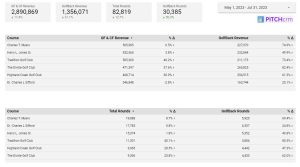In the ever-evolving landscape of the golf industry, staying ahead requires innovative approaches that enhance operational efficiency, customer satisfaction, and revenue generation. Dynamic pricing isn’t a new topic however, it has emerged as a powerful tool that holds immense potential to transform the way golf courses manage their pricing strategies.
Below we dive into the concept of dynamic pricing, its application in the golf industry, and the many benefits it brings to golf businesses looking to unlock growth.
What is Dynamic Pricing?
I assume you already have an idea but, just in case – Dynamic pricing is a pricing strategy that adapts and fluctuates in real-time based on various factors, such as demand, supply, competition, customer behavior, time of day, season, and external conditions.
Unlike fixed pricing models, which maintain constant prices, dynamic pricing enables businesses to set prices that align more closely with market dynamics and consumer preferences.
This approach harnesses the power of data analytics and technology to optimize pricing, ensuring that products or services are priced at levels that maximize revenue and reflect the ever-changing conditions of the market.
Dynamic pricing is prevalent across various industries, from airlines and hotels to e-commerce and entertainment, allowing businesses to respond agilely to shifts in demand and supply, ultimately driving greater profitability and competitiveness.
A Bit of History
Golf courses have been dynamically pricing their inventory for a long as I have been playing golf and likely for a long time before that…
At it’s core dynamic pricing is simply a supply and demand equation and is the reason why you pay more for a golf tee time in the morning than you do in the afternoon.
If the demand to play on a weekend morning is high and supply is low, then you can charge a premium. If the demand is low and supply is high on a Tuesday, then we scale the pricing back.
This is how golf courses have and still price their tee time inventory. Anyone that says they don’t believe in dynamic pricing is almost guaranteed to be using this tried and true method of supply and demand based dynamic pricing.
Why do some golf operators dislike dynamic pricing?
Even though nearly every golf operator believes in supply and demand based dynamic pricing, there has been some dis-taste for dynamic pricing in the golf community and in my opinion this came with the first utilization based dynamic pricing technology.
When I first encountered the utilization based dynamic pricing tools, they were pushed with the hopes that we would “Dynamically Discount” our tee time inventory so the purveyor of the technology toolset would sell more online tee times and make even more money off the golf course.
If you allowed this technology company to set the pricing matrices for you – which they would offer to do so again and again – they would almost certainly only add discounts and never add an increase in price even when your supply was extremely low.
I believe that this practice of pushing dynamic discounting with an ulterior motive that did not benefit the golf course was the salt that left a bad taste in many mouths.
Interested but not sure how to get started?
Easing into dynamic pricing can be a smooth transition for golf courses that are mindful about how they adjust their pricing strategy. To start off gently and get both staff and golfers accustomed to the new approach, here are some strategic steps a golf course can take.
Educate Your Team
Ensure that all staff members are well-versed in dynamic pricing principles and can confidently explain these to golfers. This helps in providing consistent information and reducing any potential confusion or dissatisfaction among customers.
Start with Peak Times
Begin by applying a slight increase to your most in-demand tee times, often early morning or weekend slots. This helps to maximize revenue during high-demand periods without a dramatic change in your overall pricing structure. It’s a subtle way to introduce dynamic pricing while still offering value to your loyal golfers during these premium times.
Discounts During Off-Peak Hours
Introduce discounts during less popular times, such as twilight or mid-afternoon slots. This encourages golfers who are price-sensitive or have flexible schedules to take advantage of lower rates, helping to increase course utilization during typically slower periods.
Communicate Transparently
Clear communication with your golfers about why you are implementing dynamic pricing is crucial. Explain that this model allows you to offer competitive pricing while maintaining the quality of the golf course. Highlight how golfers can benefit from lower prices during off-peak times.
Gather Feedback
Encourage feedback from your golfers about the new pricing strategy. This not only helps you gauge customer satisfaction but also makes your golfers feel involved in the process, which can increase their acceptance of dynamic pricing.
Why Your Golf Course Should Use Dynamic Pricing
Maximize Revenue
Dynamic pricing allows you to adjust your tee time rates in real-time based on demand, weather, and other influencing factors. This flexibility means you can charge premium prices during peak demand times and reduce rates during slower periods to attract more players. It’s an effective way to ensure you’re always getting the best possible return on each tee time.
Attract More Golfers
By offering competitive rates during off-peak times, you can attract a wider range of golfers. Those looking for a deal or with flexible schedules can take advantage of lower prices, leading to increased utilization of your course during traditionally slow periods.
Enhance Customer Satisfaction
Golfers love feeling like they’ve snagged a great deal. Dynamic pricing gives them the opportunity to play at rates that feel personalized and value-driven. This can enhance their overall experience, leading to positive reviews, repeat business, and increased loyalty.
Data-Driven Decision Making
Dynamic pricing tools use real-time data to inform pricing decisions. This means you’re not just guessing what your rates should be; you’re making informed choices based on hard data. This can include weather patterns, historical demand, competitor pricing, and more, ensuring your pricing strategy is as effective as possible.
Operational Efficiency
Automating your pricing through a dynamic model saves time and resources. Instead of manually adjusting prices and monitoring the market, your team can focus on other important aspects of running the course, such as customer service and course maintenance.
Stay Competitive
In today’s market, many golf courses are already leveraging dynamic pricing. To stay competitive, it’s crucial to adopt modern pricing strategies that reflect the current market dynamics. Not doing so might put you at a disadvantage, as savvy golfers increasingly expect flexible pricing options.
Increased Profit Margins
Dynamic pricing doesn’t just help fill up tee times; it also enhances your profit margins. By strategically pricing tee times based on demand, you can ensure that you are maximizing your revenue potential throughout the day and season.





